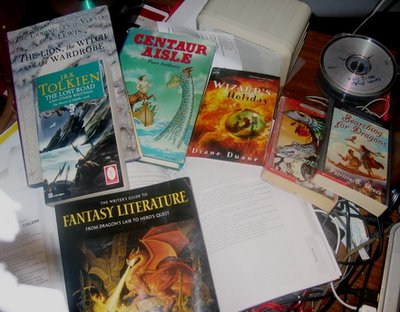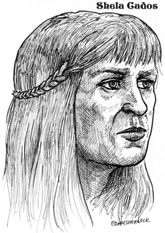I haven't yet decided whether to try first for a major science fiction and fantasy publisher, such as Tor, Ace, DAW, etc. Those publishers (or a first reader thereof) each saw some sort of submission of the book between 1992 and 1997, but it was a very different book back then. I'm supposed to be able to resubmit under such circumstances, but I'm sure it would look darn strange for me to admit that the book has been floating around for a decade - let alone 32 years from the day I first typed the name Rani on my mother's manual typewriter. This book and I have a ridiculously long history together. It was this book that taught me to write, in stages, sometimes with years of no progress in between. And it was my development as a writer that taught me to finally make this book what it is now. What is it now? Publishable, I hope!
In flipping through my 2006 Novel & Short Story Writer's Market, I've come across a glossary of publishing terms. Along with such concepts as SASE, serial rights, and slush pile, it includes definitions of certain fiction genres. The ones that matter for my purposes are the following:
 High fantasy. Fantasy with a medieval setting and a heavy emphasis on chivalry and the quest.
High fantasy. Fantasy with a medieval setting and a heavy emphasis on chivalry and the quest.Traditional fantasy. Fantasy with an emphasis on magic, using characters with the ability to practice magic, such as wizards, witches, dragons, elves and unicorns.
Urban fantasy. Fantasy that takes magical characters such as elves, fairies, vampires or wizards and places them in modern-day settings, often in the inner city.
Young adult. The general classification of books written for readers 12-18.
-Mosko, Lauren, Editor. "Glossary." 2006 Novel & Short Story Writer's Market. Cincinnati: Writer's Digest Books, 2006; pp. 554-557.
Okay, so what am I supposed to call Heirs in my cover letter or query? High fantasy? The land of Mâvarin isn't truly medieval, and has little to do with chivalry, there being no knights in either the books or the country. There is a sort of quest thingy, but not for the usual reasons. So is it high fantasy? Well, um, maybe.
How about traditional fantasy? Sure there's magic, but the terms "wizard" and "witch" are never used. As for dragons, elves and unicorns, well, there aren't any. Still, the mages are certainly in the wizardly tradition of the fantasy genre.
Urban fantasy we can discard right away. My only writing projects to date that touch on urban fantasy are the serials Meet Joshua Wander and the apocryphal Mall of Mâvarin. The actual Mâvarin books never go near the modern world.
There's also at least one wild card among my options for defining this book. Athough it's not in the glossary, the book publisher listings frequently mention sword and sorcery. Most closely associate with Conan the Barbarian, sword & sorcery is mostly about big guys with swords, often fighting evil sorcerers. Umm, yuck. Any listings that only wanted "sword and sorcery" and "space fantasy," I crossed off my list.
Still, the vague distrinction between high fantasy and tradition fantasy sent me running to Wikipedia. Traditional fantasy wasn't mentioned there, and high fantasy had at least three definitions. Wikipedia also come up with such subgenres as Comic fantasy, Contemporary fantasy, Dark fantasy, Fairytale fantasy, Historical fantasy, Low fantasy, Mythic fantasy, and Romantic fantasy. Most of these I can safely ignore, but it does all make for fascinating and confusing reading.
Another article came up with the term juvenile fantasy. This was essentially the intersection between traditional fantasy and YA fiction - in order words, Harry Potter and other fantasy novels with teenaged protagonists. Heirs only sort of fits the definition, because Del and Crel aren't magicians, and hardly ever wield magical objects.
The most interesting passage I came across in my research was the following:
Perhaps more than any other subgenre, high fantasy is criticized for borrowing too many of its themes and ideas from previous works, most notably those of J. R. R. Tolkien. Others defend this, citing that most of Tolkien's themes and ideas were taken from mythology and folklore with only superficial modifications. Nevertheless, the fact that most authors in this subgenre tend to limit themselves to those aspects of mythology and folklore that Tolkien used, and often combine them in similar ways, is one that cannot be ignored. As a result, many fans of the fantasy genre have grown exceedingly weary of the repetitious manner in which this subgenre's once most beloved characteristics recur. However, it appears that the use of such particular themes and ideas is the very thing that distinguishes high fantasy from its fellow subgenres, and that a sufficiently unique example of high fantasy would be more likely to be placed in a different subgenre altogether, thus rendering accusations of unoriginality somewhat circular.
--"Fantasy subgenres" article, Wikipedia
This observation speaks to a major source of the problems in classifying fantasy, and also my particular problem as a writer of a somewhat nontraditional fantasy novel. High fantasy is basically anything that looks to Tolkien (and maybe the King Arthur legends) as its primary literary ancestor. But if the book is too much like Lord of the Rings, insofar as having elves and dragons and such, it may seem derivative and not worth reading. If it doesn't include such creatures, it may not qualify as high fantasy at all. What's a fantasy writer to do?
 Well, the way I solved this problem, way back in high school, was to ban all dragons, unicorns, goblins, etc. from Mâvarin. I did end up with characters that were something like elves, but I made darn sure they weren't elves. They were fully human, they didn't live for centuries, they didn't have pointed ears, and they weren't called elves. Characters that other writers might have called "dwarves" were similarly treated. Deliberately keeping my distance from stock fantasy elements freed me to develop a world that stands on its own, instead of looking like a poor man's Middle Earth. But it also keeps it from fitting comfortably into categories. High fantasy usually involves saving the world from some huge overwhelming evil, and I don't have that sort of thing happening at all. (Lorsuma tries to fill that role in the second book, but even she doesn't threaten the whole world.) Traditional fantasy has wizards, and so, under another name, has Mâvarin. But to call it "traditional fantasy" seems odd with all the traditional trappings so conspicuously absent.
Well, the way I solved this problem, way back in high school, was to ban all dragons, unicorns, goblins, etc. from Mâvarin. I did end up with characters that were something like elves, but I made darn sure they weren't elves. They were fully human, they didn't live for centuries, they didn't have pointed ears, and they weren't called elves. Characters that other writers might have called "dwarves" were similarly treated. Deliberately keeping my distance from stock fantasy elements freed me to develop a world that stands on its own, instead of looking like a poor man's Middle Earth. But it also keeps it from fitting comfortably into categories. High fantasy usually involves saving the world from some huge overwhelming evil, and I don't have that sort of thing happening at all. (Lorsuma tries to fill that role in the second book, but even she doesn't threaten the whole world.) Traditional fantasy has wizards, and so, under another name, has Mâvarin. But to call it "traditional fantasy" seems odd with all the traditional trappings so conspicuously absent.So if I don't have a barbarian or a wizard as a protagonist, or a dragon or a unicorn hanging around, or elves or dwarves, or forays into contemporary reality, or knights and damsels or grails, or postmodern humor, what the heck kind of fantasy is this? It occurs to me that I've researched this question once before, years ago when I bought a book called The Writer's Guide to Fantasy Literature: From Dragons Lair to Hero Quest, edited by Philip Martin. He came up with yet another set of categories, of which high fantasy and fairy tale seem to come closest to what I do. Looking it over again now, though, doesn't bring me any closer to an answer.
So what is Heirs of Mâvarin? I guess I'd have to call it a fantasy bildungsroman, with elements of the high fantasy, fairy tale and traditional fantasy subgenres and the young adult marketing category. Do I have to define it further? Who wants to know?
Karen
5 comments:
I never realized how complicated it could get:x
Maybe I am glad I never followed through on wanting to be a writer:)
Chris
My Most Recent Entry 2/04/06
Technically according to the first three definitions you gave, Tolkein falls under traditional rather than High Fantasy. The Writer's Market definitions. I think that's why they struck me as so weird. I've never heard anybody use the tern high fantasy in a way that didn't include Tolkein, but the way it's described there basically the only thing I could classify as High Fantasy is King Arthur. I mean sure there's a quest in LOTR, but Boromir and Aragorn aren't knights, and the elves, orcs, wraiths, balrogs, dragons, etc certainly would bump it into the traditional category there. I don't equate LOTR with chivalry at all. I like Wikipedia's definitions better.
Tuff marketing decisions but I do know one thing, Heirs of Marvin is your fantasy and you have done well in developing it. Good luck on the publishing trail!
It's unfortunate that the writing industry forces you to put yourself in some sort of box with a label of their choosing. I'm trying to think what I'd call my fantasy, "Dark Side of the Moon". Probably an erotic mythical fairy tale for adults only.
But the people, literary agents and editors alike, are all so impressed with themselves, and seem to feel that only they can call the shots, so you have to play the game.
Have you noticed how they all sign their letters and correspondance with "Best" ?
Real creative.
It seems like you've stumbled onto one of the biggest problems of popular culture. Everything has to fit into a nice cozy box. You see it in books, music, movies, etc. Submit your book everywhere until you find a publisher and don't worry so much about genres. Let the publishers decide if it's what they want.
Post a Comment